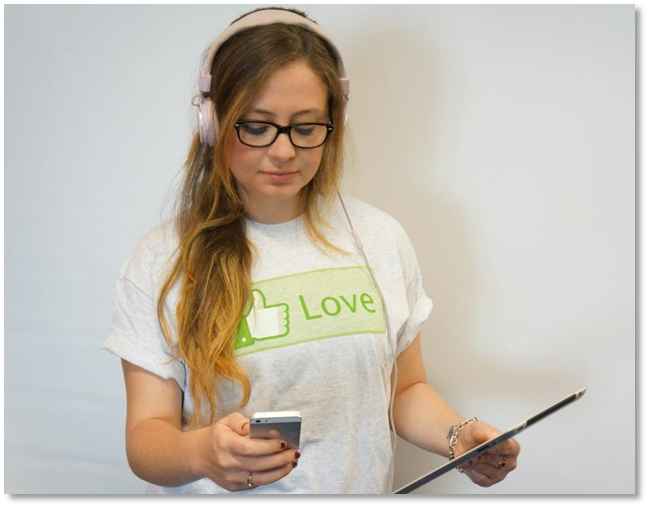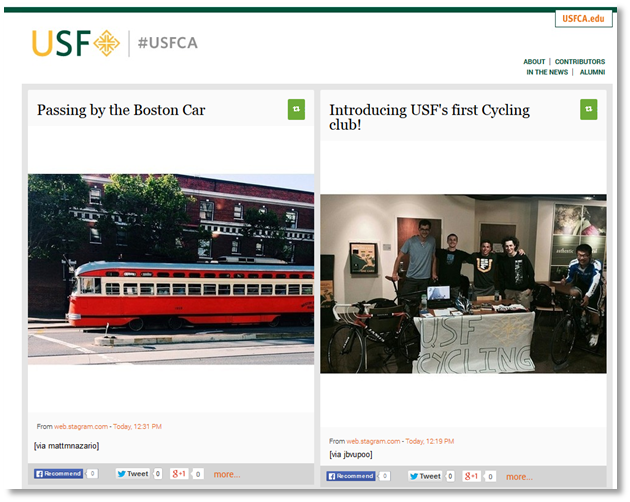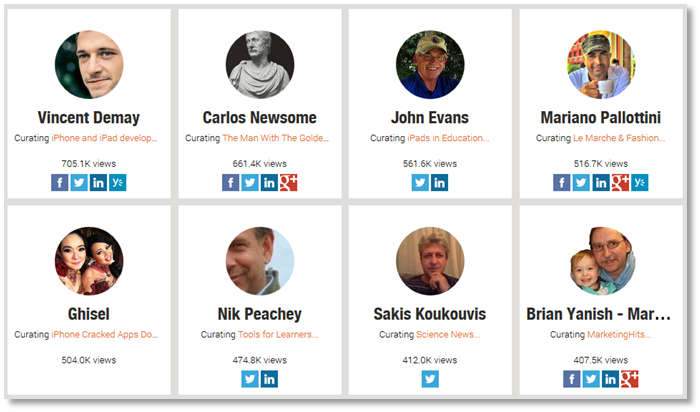
Photo: Ally Greer of
Scoop.it.
Everyone, Meet Ally
I met Ally during Community Manager Appreciation Day 2014. It was a virtual meeting: Ally moderated a panel discussion (via Google Hangouts) on the topic of "
Communities Around Content." A few short weeks later, I had the pleasure of meeting Ally in-person at CMX Summit in San Francisco. Ally helps manage the #Leancontent Meetup in the Bay Area. Check out their Meetup page for further information.
Content Curation Explained
Q: What does “content
curation” mean to you?
A: Content
curation is the meaningful selection, organization, publishing, and sharing of
content based upon a specific topic. Curation is more than just gathering
information and sharing it en masse. It involves finding the best content on a
certain topic, adding value to it as an expert on that topic, and presenting it
in a way that ensures readers will benefit more from reading it than if they
were simply given a list of articles.
Content Curation for B2B
Q: How can B2B brands
leverage content curation?
A: Content
curation is, in my humble opinion, the best way to stay top of mind to your
potential customers, as well as your existing audience. When you're relying
solely on creation, it's highly unlikely that you'll have enough content to
constantly be posting and sharing fresh, relevant information.
Supplementing
this with meaningful curation is an amazing way to
exponentially increase the
number of times you're posting
on social media and providing your clients -
current and future - with the relevant information that they need in order to
move forward in the buying process.
Q: Name a few B2B brands
who are doing content curation well?

Image: Bonitasoft's
curated blog, powered by Scoop.it.
A: Bonitasoft
is doing a great job with their curated blog. They have a gorgeous introduction and have even
used curation to engage with their community by encouraging post suggestions.
It's not easy to build community in the B2B space because most of your clients
want your solution and nothing more.
However, connecting over ideas and
information is a great way to build relationships.
RealChange is
also doing a great job of this by sharing information specific to Silicon
Valley, where they're located.
Additionally,
Modallic, a mobile health marketing agency, uses curation to
showcase their knowledge and
become a resource for current and potential clients. Once they've established
themselves as knowing everything they need to know about the space, they're
more likely to be trusted by their future clients.
Using Content Curation
Q: Are there any dangers
with doing content curation?
A: There are many ways to do it wrong. Sharing links isn't curation - it doesn't
add value and the original author might feel as though the curator is trying to
take the lazy way out. Relatedly, not giving proper credit can result in
negative reactions from original creators as well as potential legal issues.
When done properly - read: adding value and perspective and always giving
credit -
curation can only help boost your online presence and brand.
Q: What’s the most
creative use of content curation that you’ve seen?

Image: the University of San Francisco uses
Scoop.it for content curation.
A: I just love
what the
University of San Francisco is
doing with content curation. They have
all of their students
sharing photos, articles, experiences, etc across all social channels with the
hashtag #usfca. Then, a team of curators goes through these posts (brought together
in the
Scoop.it suggestion engine) and posts
the best ones with some context. As a result, they have an awesome,
interactive, community-curated page of all the happenings within the USF
community.
Measuring the ROI of Content Curation

Q: How can marketers
measure the ROI of their content curation efforts?
A: There are
many ways curation can have an impact on business goals. In fact, here's a
report from a survey we
conducted on just that! There are many ways to measure the ROI of content
curation, but the first step is to figure out (before you create your curation
strategy) what you want to accomplish.
Photo source: Simon Cunningham on
flickr.
If you want lead generation, then you
can use curation to build a
webpage filled with content that brings in new
leads. If your goal is audience engagement, you can use curation to fill your
online presence with a consistent stream of relevant content that's appealing
to your audience and see which pieces of content garner the most reactions.
Curation isn't going to be the answer to all of your business goals, but its
impact can certainly be seen as a part of a greater content strategy.
Q: What’s the one thing
marketers are NOT doing well in content curation?
A: In my
opinion - and there might be a theme starting to form here -
most marketers
don't fully understand what content curation entails
and what's required in
order to be a successful curator. There are so many tools out there claiming to
be "curation" tools, while they're mostly just aggregators.
Collecting content and spamming your social channels with it isn't going to be
useful in any way (unless your goal is unfollows! :)). Relatedly, a lot of
marketers fail to see the benefit of curation
because they're
seeing others do it incorrectly and think that that's what it is. If I could make
marketers aware of one important thing about curation, it would be that you
must take
the time to add value to the content you're sharing to set a better example for
other marketers as well as to achieve success with your business goals.
Miscellaneous Content Curation Topics
Q: Which curators do you
follow or subscribe to?
A: Here are some of my favorite curators on
Scoop.it.

Image: Some of Ally's favorite curators on Scoop.it.
Q: What’s the future of
content curation?
A: Content
curation has already begun making the
transition from an unclear buzzword to an
actual digital marketing strategy. At Scoop.it, we view it as such:
First,
curation was a word only associated with museums and "real life" art
collections. Then, around 2011-2012 it started making the rounds as a marketing
buzzword that no one actually truly understood, but the important thing that
the conversation had begun.
In 2013, curation was the up-and-coming strategy
that the early adopters and experts claimed would be the next big thing and
everyone became aware of the fact that it was increasingly necessary.
Now, 2014
is the year where curation is somewhat mainstream in the marketing world and
everyone knows that it's necessary. This year, the question is why. We're past
the stage of knowing it's important, and
this is the year where the results
will start coming through
and digital marketers will finally see the value and,
eventually, it will be a regular part of content strategy.
Outside of
the marketing world, curation is taking over the web in 2014. Think about all
of the top websites of today: Huffington Post, Buzzfeed, Upworthy, Business
Insider. They have one thing in common: they're operating with a healthy mix of
original content creation and curation.
As more and more information is
published online (anyone can write a blog post these days!), the ones who
succeed and manage not to get lost in all the noise will be the ones that
embrace the large amount of content and curate it along with their original content,
instead of being intimidated by it and giving up altogether.
About Scoop.it

Q: Tell us a bit about Scoop.it, including your role
there?
A: Scoop.it is
a platform that allows anyone, from students trying to get into the
professional world to consultants to small businesses to large enterprises, to
discover, organize, and share ideas that matter to them. If you're sharing
content online, chances are you're already a curator and don't even know it.
Scoop.it provides a
content discovery engine to help find the best and most
relevant content on your or your brand's topic of expertise, as well as a place
to publish this content with your personal insight (value add!) and share it to
all of your social networks in one click.
On the larger scale, Scoop.it is
revolutionizing the internal knowledge management processes of large
organizations by working with enterprise clients to create private information
sharing networks within companies. If you'd like to learn more about that, well
that's easy, just ask!

5 Incredibly Valuable Ways Marketers Can Use Branded, Online Communities
By Marisa Peacock
I'm
Scoop.it's Director of Community & Content and in this position, I represent three out of the
five main use cases of the Scoop.it community.
- As a community manager, I lead
efforts to maximize customer success and happiness through support, as well as
ambassador and advocacy programs within the Scoop.it community and a
meetup series beyond our community. I
use curation to back up the
content
of the meetups as well as building
advocacy through content.
- As content director, I run the Scoop.it blog which is filled with
original content created by myself and our team, content from a guest writer
program (want to write?
Tweet me!)
and of course, curated content from our
Scoop.it
pages.
- Finally, as social media manager, I share content to build the
Scoop.it brand as a thought leader in the content curation space, as well as to
engage with our audiences on multiple platforms.